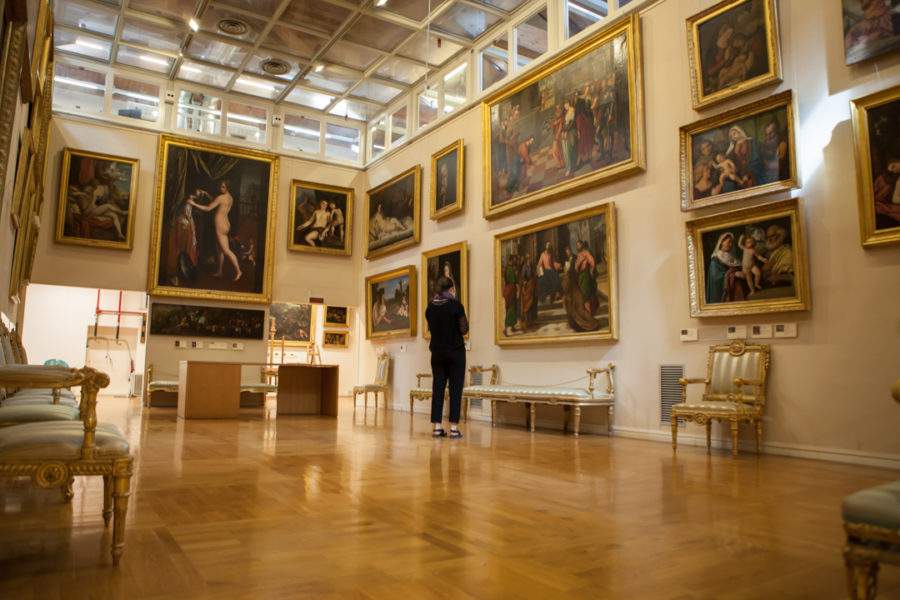This is how we will visit Museums: MiBACT publishes rules. Mask and gloves mandatory, 1.5 m distance
The General Directorate of Museums of the Ministry of Culture and Tourism has published the joint statement for the reopening of state institutes and places of culture in implementation of the Protocol of Agreement for Prevention and Safety Public Employees for Health Emergency Covid-19: basically, these are the rules that we will have to follow to visit museums and with which the workers of the institutes will also have to comply. So we are talking about museums but also archaeological parks, libraries, archives, monumental complexes as identified in Article 101 of the Cultural Heritage Code. Let’s look at them in detail.
It starts with the measures to be complied with both outside and inside the places of culture:
- Information obligations on the part of the employer with regard to staff and anyone who enters the Institutes and places of culture and workplaces in order in order to the anti-contagious measures taken and about the epidemiological risk in progress, as well as on the behavior to be taken according to the specificity of the site and the mode of enjoyment that has been decided to undertake. To this end, posters/leaflets/brochures publicizing the above measures may also be posted.
- For workers, there is an obligation to wear disposable personal protective equipment (masks, latex gloves), and in the case of a significant influx of the public, a protective clear plastic visor is also mandatory (the latter also mandatory for rescue teams). MiBACT personnel must use only CE-marked masks.
These are the measures and procedures to be observed outside:
- Mandatory presence of external information apparatuses (panels or notices) containing methods and times of visitation (or reception of the public and outside firms), including signaling of the obligations of the public;
- Mandatory presence of antiseptic soap dispensers and signage on their location;
- Check by staff on the public to ensure that they are equipped with masks and gloves: staff must provide i.p.d. if visitors/users are found to be without them;
- Progressive installation of thermoscanners in cultural venues with high concentration of visitors (i.e., with attendance of more than one hundred thousand visitors per year);
- Progressive installation of body temperature measurement devices in cultural venues with attendance of up to one hundred thousand visitors per year and in other workplaces.
These are the measures to be complied with inside places of culture.
- Obligation to wear disposable personal protective equipment (CE-marked masks, latex gloves) until the end of the visit for the public and until the end of working hours for employees;
- Mandatory presence of antiseptic soap dispensers and signage on their location;
- Progressive installation of plexiglass panels to ensure compliance with “social distancing” in the division of work spaces within common areas;
- Arrangement of entrances that are contingent in quantity and frequency, including the possibility of reservation entry, for all cultural venues;
- Arrangement of exoduses staggered in time to avoid overlap with incoming flows;
- Progressive set-up of visit routes defined with respect to both specific content themes and site size;
- Supervision of compliance with “social distancing,” which should be at least 1.5 meters between visitors, either by verbal reminders or by broadcasting recorded messages to be played at regular intervals;
- In confined places there shall be adequate natural ventilation of the premises and compliance with recommendations in the presence of ventilation and/or air conditioning systems;
- Obligation to use elevators, lifts or hoists one person at a time, with the obligation to wear PPE;
- Obligation to quota the presence of personnel in the refreshment areas/control rooms/monitor rooms/common rooms, with always the strict obligation to wear i.p.d.’s;
- Obligation to ensure strict hygiene of work environments (carried out with the appropriate products) with frequency proportionate to their use, and of the contact surfaces of any food and beverage vending machines;
- Obligation to ensure frequent hygienization of toilets for employees and users;
- Obligation to ensure the periodic cleaning of ventilation and air conditioning systems;
- Obligation to ensure daily cleaning of restrooms, elevators, cmuni rooms, dining areas, control rooms, both at the beginning and end of working hours;
- Obligation to ensure daily cleaning of working environments, with special attention to spaces frequented during shift change, contact surfaces;
- Obligation to periodically sanitize keyboards, touch screens, mice with appropriate cleaning agents;
- Obligation to sanitize immediately if any Covid-19 infection is detected;
- Regulate shifts so as to avoid assemblages in on-call bodies without proper spacing;
- Obligation to use gloves when using common materials (e.g., pens and pencils) and obligation to sanitize items after each use.
The applications of the standards will be subject to periodic review. Since the guidelines are those of MiBACT, they will apply to state cultural sites (such as Uffizi, Galleria Borghese, Pompeii, National Central Library of Florence, State Archives, etc.). This means that civic, diocesan or private museums could work out rules even profoundly different from those just listed.
Pictured: a room in the Borghese Gallery.
 |
| This is how we will visit Museums: MiBACT publishes rules. Mask and gloves mandatory, 1.5 m distance |
Warning: the translation into English of the original Italian article was created using automatic tools. We undertake to review all articles, but we do not guarantee the total absence of inaccuracies in the translation due to the program. You can find the original by clicking on the ITA button. If you find any mistake,please contact us.





























